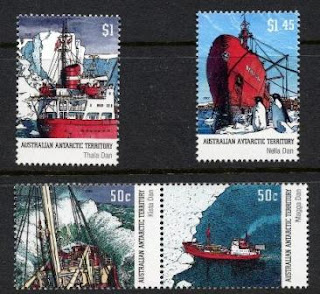Canada Post will issue two stamps May 4 to commemorate the establishment of the Royal Canadian Navy.
The commemorative stamp issue depicts the past and present of Canada's naval service.
"The two stamps were designed as separate artworks, but they appear as one canvas. They share the same painterly sky, marine life and open sea environments. The two ships, though of a different age, appear as part of the same fleet," notes designer Andrew Perro of the Toronto-based firm, Designwerke. "One of Canada's first warships, the HMCS Niobe, sails alongside a modern frigate, the HMCS Halifax - a feature that speaks to the passage of time, capturing the magnitude of this major centennial milestone." The design is complimented by marine inspired colours and crisp typography
Details of HMCS Niobe :
Niobe had served in the Royal Navy from 1898 to 1910, one of eight sisters of the Diadem class. She was commissioned in the RCN on September 6, 1910, at Devonport, and arrived at Halifax on October 21. Niobe was nearly lost during the night of July 30-31, 1911, when she went aground off Cape Sable, necessitating repairs that were not completed until the end of 1912.
In the fall of 1914, after the ravages of two years' disuse had rectified, she joined the RN's 4th Cruiser Squadron on contraband patrol off New York .
Worn out, she returned to Halifax on July 17, 1915, never to put to sea again. She was paid off that September 6 and became a depot ship. Her upperworks were wrecked in the Halifax explosion of December 6, 1917, but she continued to serve as a depot ship until 1920, when she was sold for scrap. Niobe was broken up at Philadelphia two years later.Details of HMCS HALIFAX
HMCS HALIFAX, FFH 330, was built in Saint John, New Brunswick, and commissioned in Halifax on 29 June 1992. She is the first of twelve “HALIFAX” Class Frigates and one of the most capable frigates in the world.
Between April and August 1994, HALIFAX was deployed on her first Standing Naval Force Atlantic (SNFL), during OP SHARK GUARD, enforcing UN sanctions against former Yugoslavia.
In May 1995, HALIFAX had the honour of attending VE celebrations in Oslo, Norway and in Gydnia Poland. HALIFAX was the first Canadian Warship to visit Poland since the end of WWII.

















